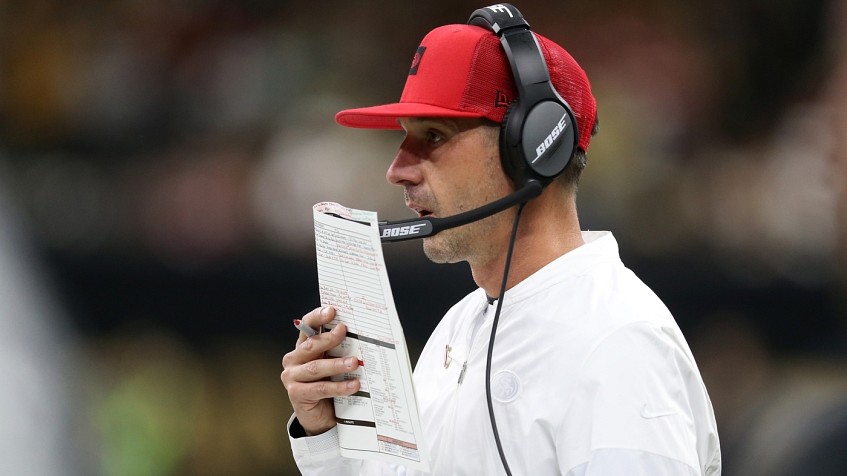Defenses have evolved as well, in order to counter these offensive changes, by getting smaller and quicker at positions that were traditionally manned by larger, more physical players. This has resulted in linebackers who are built more like large safeties, and defensive tackles who are smaller, and quicker, as opposed to hulking, run-stuffers. It appears that Kyle Shanahan is evolving his offense to counter these defensive adaptations by going with a "heavier" approach and a 22 personnel attack in 2020.
In the NFL, personnel packages are named after the number of running backs and tight ends in the formation; 22 personnel means 2 running backs (usually a fullback and a tailback), 2 tight ends, and 1 wide receiver. Typically for NFL teams, this package would be used in obvious running situations, like 3rd and short, or at the goal line. Adding two tight ends and a fullback puts eight blockers in the game, allowing for a best-case scenario when blocking for a run. The defense has to react to this personnel grouping by bringing in bigger bodies to stack the box anticipating said run. This is the advantage the 49ers will look to exploit.
Let's do a thought experiment: imagine a formation with George Kittle on one side of the offensive line, and Jordan Reed on the other side. Two dynamic pass catchers whom linebackers have trouble covering. Then, add Kyle Juszczyk and Jerick "Jet" McKinnon in the backfield, and you have five legitimate pass-catching weapons, including whichever receiver is in the formation.
Typically, when a team has five pass catchers on the field, it is in 11 personnel (1 RB, 1 TE, 3 WR) or 10 personnel (1 RB, 0 TE, 4 WR). When faced with these personnel groupings, a defensive coordinator would almost always send in a nickel or dime package, which puts six or seven pass defenders on the field. However, with the 49ers' 22 personnel package on the field, it puts the opposing defensive coordinator in a crisis situation: does he set up his defense to stop the run or the pass?
If they commit to stopping the run by staying in base defense, any one of the five receiving options will have a distinct advantage, especially the four against the linebackers or safeties charged with covering them, likely leaving quarterback Jimmy Garoppolo with multiple open targets. If the defense chooses to defend the pass by going to a nickel or dime package, the 49ers could maul the defense with Kittle lining up next to left tackle Trent Williams, Jordan Reed lining up next to right tackle Mike McGlinchey, and fullback Kyle Juszczyk coming out of the backfield to open up huge holes for Jet to fly through. The bigger and stronger 49er blockers would easily move the smaller pass defenders against their will.
Look for the 49ers to capitalize against defenses early in the season. This could be the advantage Kyle Shanahan is looking for. Being equally dangerous to either pass or run out of 22 personnel means big gains for the 49ers. Either way Shanahan decides to slice it, the 49ers will be carving up defenses when they choose to bring out their lucky number, the 22 personnel.
Written By:
Lifelong 49ers Fan. Father. Husband. Full-Time Educator. Former College QB. Co-Host of The Denim Dungeon Podcast.
All articles by Tim Sprinkles
Tim Sprinkles
Lifelong 49ers Fan. Father. Husband. Full-Time Educator. Former College QB. Co-Host of The Denim Dungeon Podcast.
All articles by Tim Sprinkles
More San Francisco 49ers News
-
Why Mike Mayock sympathizes with Kyle Shanahan amid 49ers revamp
Former Las Vegas Raiders general manager Mike Mayock recently joined The Rich Eisen Show to share his thoughts on the surprising offseason moves in Santa Clara. The San Francisco 49ers have allowed several veteran players to leave in free agency, leaving the team poised to look... -
The Real Case with 49ers QB Brock Purdy
Full disclosure: I am not a journalist. I am not a journalist from the Bay Area who is tuned in to inside sources, such as Matt Maiocco and Matt Barrows, who have been nailing it for decades. No, I am the voice of reason, the voice of the reality check, and today it's "the... -
49ers projected to land former Giants pass rusher
The San Francisco 49ers desperately need defensive linemen after releasing Javon Hargrave, Leonard Floyd, and Maliek Collins—all of whom quickly signed lucrative deals with other teams. Next month, the Niners will likely use multiple draft picks to address the trenches,... -
Former 49ers foe joining 3rd team in 3 years
Russell Wilson's time with the Pittsburgh Steelers lasted just one season. The veteran quarterback, a longtime nemesis of the San Francisco 49ers, is reportedly signing a one-year, $10.5 million deal with the New York Giants, which could rise to $21 million with...
